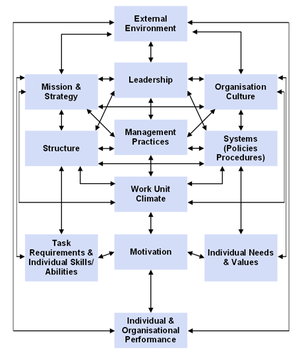Causal Model of Organizational Performance and Change
The Causal Model of Organizational Performance and Change, also known as the Burke & Litwin Model, suggests linkages that hypothesize how performance is affected by internal and external factors. It provides a framework to assess organizational and environmental dimensions that are keys to successful change and it demonstrates how these dimensions should be linked causally to achieve a change in performance. The causal model links what could be understood from practice to what is known from research and theory. The model not only discusses how different dimensions link with each other but also discusses how the external environment affects the different dimensions in an organization. The model focuses on providing a guide for both organizational diagnosis and planned, managed organizational change, one that clearly shows cause-and-effect relationships.[1]
Burke-Litwin Model: Understanding Drivers for Change[2]
The Burke-Litwin model shows the various drivers of change and ranks them in terms of importance. The model is expressed diagrammatically ( see figure below), with the most important factors featured at the top. The lower layers become gradually less important. The model argues that all of the factors are integrated (to greater or lesser degrees). Therefore, a change in one will eventually affect all other factors.
Burke-Litwin believe environmental factors to be the most important driver for change. Indeed, most change can be traced back to external drivers for change. Important elements of organizational success, such as mission and strategy, leadership, and organizational culture, are often impacted by changes that originate outside the organization. It is one's job to understand these external changes and identify the implications for the team.
- External Environment: This includes such factors as markets, legislation, competition, and the economy. All of these will have consequences for organizations, and, as a change manager, it is vital that you continually scan the environment for issues that will affect you and your team. For example, in the world of accountancy, International Accounting Standards and International Financial Reporting Standards will have a significant impact on the way companies manage their accounts and report their results. In the public sector, legislative changes across health, local government, and other services have a direct impact on the work organizations are required to carry out.
- Mission and Strategy: An organization’s mission articulates its reason for existing. It is the foundation upon which all activity should be built. The strategy then sets out, in broad terms, how the organization will go about achieving its mission. Very often, the strategy will be developed in light of environmental change and will have a significant impact on the work you do. As a change manager, you need to understand the change in strategy and be able to communicate the implications to your staff.
- Leadership: This considers the attitudes and behavior of senior colleagues and how these behaviors are perceived by the organization as a whole. The way in which change is implemented and accepted through the organization will be largely influenced by the top team. Does your team believe that senior colleagues are committed to change, or is it just another initiative that will disappear in six months’ time?
- Organization Culture: Organization culture can be described as “the way we do things around here”. It considers the beliefs, behaviors, values, and conventions that prevail in an organization. Cultural change does not happen overnight. It evolves over time as a result of many other changes in the organization. As a manager, you should keep in mind the desired state of the organization, in terms of how you expect people to behave (and not to behave), and what your organization values as important. You need to ensure that your behavior fits with these expectations at all times and that you ‘walk the walk’.
- Structure: Very often, changes in strategy can lead to changes in the way the organization is structured. This can impact relationships, responsibilities, and ways of working. Your job is to assess the impact of the structural change and ensure your team understands why it is required, and what it means for them.
- Work Unit Climate: This considers employees’ perception of their immediate colleagues and the working environment. Our immediate working environment is often what shapes our view of the organization as a whole, and influences the extent to which we feel satisfied in our jobs. Changes to the immediate working environment need to be managed sensitively, as they are likely to invoke a range of emotional and political responses from staff. This is particularly the case where change involves moving location, a change in personnel, or a change in terms of conditions of service, such as working hours.
- Task Requirements and Individual Skills/Abilities: Change at a higher level in the organization will often require changes in the work carried out and the skills available in the team. As the change manager, you need to assess whether: all the right skills are in place; if they can be developed; or, if you need to bring them in from outside the team.
- Individual Needs and Values: Changes to team membership can mean a change in the team dynamic. In a perfect world, we would be able to recruit the exact fit for our teams, in terms of personal style, abilities, and skills mix. However, in reality, it is not always possible, and it is your job to identify any risks in these areas and mitigate them as best you can.
- Employee Motivation: Considers the significance of individual and organizational goals. Motivation is key to effective change. The real challenge is to maintain motivation throughout a change project, particularly when change is often not well-received by those affected.
See Also
Organizational Culture
Chaordic Organization
Organizational Change Management (OCM)
References

